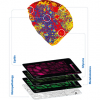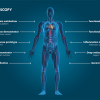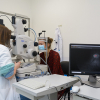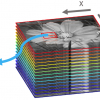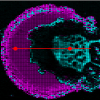Kepa Castro, Silvia Fdez-Ortiz de Vallejuelo and Juan Manuel Madariaga
University of the Basque Country, Faculty of Science and Technology, Department of Analytical Chemistry, PO Box 644,
48080 Bilbao, Spain. E-mail: [email protected]
Introduction
Fireworks are widely used to entertain audiences at events such as music concerts, theatre and street performances, local and popular festivals, New Year’s Eve celebrations, during sports events (for example, Olympic Games, American Super Bowl, European Football League) etc. and have become a very important part of these celebrations in our life. Anyone who has seen a firework display will admit that for impressive grandeur, colour effects and contrasts of light and shade, pyrotechny is unapproachable. In fact, almost no other form of amusement is capable of giving enjoyment to so many people of all classes and tastes at any one time.1
As in many aspects of our life, chemistry is also linked with fireworks and the fireworks industry. In fact, fireworks are a mixture of different chemicals that, after burning in the proper way, produce the well-known light, colour and sound effects. In addition to sulfur, saltpetre (potassium nitrate) and charcoal, fireworks often contain different salts and fuels. For example, copper salts produce blue flames, whereas lithium salts produce red flames, barium salts are responsible for the green colour, calcium for the orange colour and sodium for the yellow colour. Saltpetre is used as an oxidiser, but other compounds are possible, such as chlorates, perchlorates and other nitrates. Metallic particles (aluminium, titanium) can also be present to produce brilliant effects, as well as organic matter used as a fuel or propellant for the combustion of the firework.
The skills of the firework manufacturer in mixing all these chemicals, as well as in the design of the way they are distributed within the firework, produces the enthralling, entrancing and marvellous light, colour and sound effects. To the average onlooker, any firework which rises into the air is a rocket; in contrast, there are many different types of fireworks: lanterns, rockets, Catherine wheels/pinwheels, jumping crackers, squibs and even liquid fireworks for indoor use.1
However, fireworks have also been used during riots, in street demonstrations, inside football stadia etc. by violent protest and extremist groups and hooligans and they can be used to cause aerial disasters and severe injuries etc. Every year, tons of indoor pyrotechnics are confiscated by police and local authorities in almost every country. It must be taken into account that fireworks are considered to be low explosives and, subsequently, they are subjected to strict legislation in all countries; the manufacturing process, storage, transport and sale are strictly regulated and restricted. Police forces fight against the illegal commerce, business and storage of such substances.
Great efforts have been expended in the detection of high explosives such as trinitrotoluene (TNT), octogen (HMX), cyclonite/hexogen (RDX) and pentaerythritol tetranitrate (PETN)2,3,4,5 and rapid and direct analytical protocols for the detection of explosives have been developed for security and counter-terrorism issues, even being implemented in airports, customs and seaport offices.6 From the forensic point of view, very interesting analytical methodologies have been described for establishing criminal evidence7,8 and it is now possible to determine explosive residues even after explosions.9,10 In contrast, it seems that low explosives and pyrotechnic artefacts have been scientifically ignored. Consequently, in order to support accusatory evidence, appropriate analytical forensic studies are required.
It is also well known that in many of these artefacts, non-allowable hazardous and risky substances for human beings are employed. For instance, Croteau et al.11 found evidence for unalloyed Mg, which is banned from consumer fireworks in the USA. In the European Union, the REACH (Regulation, Evaluation, Authorisation and Restriction of Chemicals) Regulation12 covers a process for which those substances that are considered to pose an unacceptably high risk to human health and the environment may be removed from the market unless there is a justifiable need for them to remain in use. Thus, a control of these kinds of artefacts should be recommended and it is another reason for the development of analytical protocols for their analysis.
Samples
Several cracker fireworks were sent to our laboratory in order to find out whether they really were recreational fireworks and to determine the chemical composition of all of them. The (cardboard) cartridge of each artefact was opened to obtain the solid powders that were the object of the analysis. No other pre-treatment was performed on the samples except those appropriate to each analytical technique. In addition, several liquids/gels, putatively used as indoor (theatre) fireworks, were also analysed to determine their chemical composition and identify potential firework materials used in their manufacture.
Analytical approach
Raman spectroscopy is a very valuable tool for explosives detection,6,13 thanks to its non-invasiveness and the non-destructiveness of the samples, a critical characteristic when irreplaceable samples or evidences have to be analysed. However, the interpretation of the Raman spectra is not trivial and care must be taken. Unfortunately, not all the compounds present in fireworks are Raman active, thus, complementary techniques are needed, such as Fourier transform infrared (FT-IR) spectroscopy, scanning electron microscopy, scanning electron microscopy-energy dispersive spectroscopy (SEM-EDS) etc.14,15,16
In the present work, a combination of Raman spectroscopy and SEM-EDS is proposed. Sample preparation is described in the literature.15,16 Raman analysis was performed using a Renishaw InVia Raman spectrometer joined to a Leica DMLM microscope. The system is equipped with two lasers, 514 nm (ion–argon laser) and 785 nm (diode laser). Laser power was reduced in order to avoid sample photo-decomposition and possible explosions. The obtained Raman spectra were compared with several database spectra17,18 as well as against our own collection of spectra.
A scanning electron microscope (Carl Zeiss) coupled to an energy-dispersive X-ray spectrometer (Oxford Instruments) was used for electron image acquisitions and elemental composition determination. The elemental analysis was carried out using an 8.5 mm working distance and an acceleration voltage of 20 kV. EDS distribution maps of the elements as well as EDS false-colour images were obtained for a better interpretation of the data. As the samples may contain carbon compounds, they were not covered with graphite to avoid interference.
Results and discussion
The analytical procedure consisted first of an SEM-EDS analysis in order to determine the elemental composition of the samples and the distribution of the elements, followed by a Raman spectroscopic analysis to obtain the molecular composition. The elemental chemical information was used to help in the interpretation of the molecular data. To illustrate this approach, several examples are discussed below.
One of the samples analysed in our laboratory presented a grey powder appearance, together with some grey fibres. SEM-EDS analysis showed the presence of N, O, C and Ti. A more detailed mapping of the elements in different areas revealed a high coincidence among the distribution maps of N, O and C, whereas Ti appeared concentrated in spots of around 100 µm in size. EDS spectra of the Ti particles did not present any other element (EDS spectrum in Figure 1). However, the match among the elemental mapping for C, N and O revealed the presence of an organic compound. Figure 1 shows a false colour image (Cameo option in Oxford software) obtained after EDS mapping where the red colour represents the energies of N, C and O and the blue colour represents the energies of Ti. These kinds of representations, together with the single distribution of the elements along the mapped area, are of great value at the time of interpreting experimental data, and give valuable clues for the interpretation of the Raman data.

After SEM-EDS analysis, a Raman study was carried out. In this case, Raman spectra only showed the bands due to nitrocellulose (bands at 146, 209, 406, 561, 627, 696, 844, 921, 1001, 1062, 1087, 1126, 1156, 1285, 1366, 1419, 1456, 1662, 2901, 2974 and 3016 cm–1).19 Thus, this sample was, in fact, a mixture of nitrocellulose (also known as guncotton) and metallic titanium particles. Nitrocellulose is the propellant (and it is considered a low-order explosive) or fuel, whereas the titanium particles are responsible of the sparkles when the firework is burned.
More surprisingly was the analysis of a light yellow powder sample. The SEM-EDS mapping and false-colour image analysis showed different types of grains (see Figure 2). On the one hand, large grains rich in chlorine, nitrogen and oxygen were found, while on the other hand, there were grains detected that were rich in barium, nitrogen and oxygen. In the false colour image (Figure 2) the blue colour represents the energies due to the presence of Ba, whereas the red colour represents the energies due to the presence of N and Cl. The distribution maps along the mapped area of C, N and O also showed a strong correlation. Individual EDS analyses of the single grains also corroborated the results obtained during the mapping measurements.

SEM-EDS results were contrasted and complemented with Raman analysis. For example, Raman bands located at 1047 cm–1, 732 cm–1 and 141 cm–1 (see Figure 2) indicate the presence of barium nitrate,20 whereas Raman bands belonging to ammonium perchlorate were located at 462 cm–1, 627 cm–1 and 935 cm–1 (Figure 2).21 In addition, principal bands indicating to the presence of nitrocellulose were also found at 408, 560, 625, 698, 846, 1283 and 1366 cm–1. Thus, in this sample, a very powerful and unstable oxidiser (ammonium perchlorate) was present and mixed together with another oxidiser (barium nitrate) and a propellant (nitrocellulose). Barium nitrate would also be present for the green light radiating compound.
Following this analytical approach we were able to elucidate the composition of other samples, in which complex mixtures were used. In a yellowish sample, a mixture of shellac, an organic resin used as fuel in the pyrotechnic industry and strontium nitrate were found. In this case, strontium was the element responsible for the red light emission. In another black powdered sample, potassium nitrate was found mixed with carbon, elemental sulfur (S8) and an aluminosilicate. However, in another black sample, potassium nitrate was found mixed with graphite, aluminosilicates, quartz, anatase (TiO2) and elemental sulfur. As mentioned above, the chemistry of a firework can be very complex, but if a suitable analytical approach is used, it is possible to elucidate its whole chemical composition.15,16
However, more challenging is the analysis of pyrotechnic liquids used indoors. The basic composition of these artefacts is usually a flammable solvent mixed with a compound that, after it is ignited, produces coloured light, smoke or sparkles. The compounds mixed with the solvent can be organic or inorganic or both. In the particular case of the gels, the mixture also has a thickener; usually, a piece of cotton or fabric is impregnated with the liquid and ignited.
In all cases, solvent analysis can be first carried out using Raman spectroscopy. In some samples methanol was found, whereas in others, isopropyl alcohol was determined as the solvent. The use of methanol came as a surprise. Methanol is highly poisonous for human beings22 and it has a special restricted use regulation in many countries.
In one sample, methanol was mixed with boric acid, which emits green light when burning. In this case, boric acid was determined by Raman spectroscopy after the EDS analysis, which showed a high correlation between B and O. Boric acid is a rather toxic compound.23 Recently, the group of chemicals known as Borates (including boric acid) were reclassified as “Reprotoxic Category 2” by the European Union’s REACH legislation. This classification suggests that the product, in high doses, is harmful to the reproductive functions of humans. This also means that the sale of products with boric acid in concentrations above 5.5% to the general public is banned!
In another liquid sample, after methanol was evaporated and the residue was submitted to Raman spectroscopic analysis, no conclusion could be obtained because no Raman signal was observed. Moreover, EDS analysis only revealed the presence of chlorine. This analysis was not an easy task because the residue was very deliquescent. The hygroscopic properties of the precipitated solid and the absence of any other element except chlorine in the EDS analysis, made us suspect the presence of a lithium salt. As lithium is too light to be detected by EDS analysis, flame atomic absorption analysis (FAAS) was carried out to determine if it was present in the sample. As expected, FAAS revealed the presence of lithium. Lithium chloride is used in pyrotechnics to produce red colour24 and it is soluble in methanol and highly deliquescent. Lithium chloride was also found in another sample mixed with methanol and silica gel. In the sample in which isopropyl alcohol was used, hydroxypropyl cellulose was determined by Raman spectroscopy.
Concluding remarks
With the combination of selected, complementary analytical techniques, it has been possible to analyse several fireworks and materials used to manufacture indoor fireworks. The task is not trivial because the possible combination of chemicals present in these kinds of artefacts is large. The advantages of Raman spectroscopy to analyse firework materials are achieved through the possibility of focusing on individual grains, thereby obtaining the spectrum of each grain and avoiding band overlap. In addition, Raman spectroscopy allows for the identification of solvents directly, without any sample preparation. Moreover, the combination of Raman spectroscopy and SEM-EDS turns out to be very efficient. In fact, these complementary techniques may also be used to analyse other kinds of pyrotechnic artefacts, low explosive formulations, high explosives, explosion residues etc.
Acknowledgements
Technical and human support provided by SGIker (UPV/EHU, MICINN, GV/EJ, ERDF and ESF) is gratefully acknowledged in the Raman and SEM-EDS analysis. Part of this work has been supported by the Environmental Analytical Chemistry 2007–2012 project (Basque Government, ref. IT-245-07).
References
- A.St.H. Brock, Pyrotechnics: The History and Art of Firework Making. Daniel O’Connor, London, UK (1922).
- E.M.A. Ali, H.G.M. Edwards, M.D. Hargreaves and I.J. Scowen, “Detection of explosives on human nail using confocal Raman microscopy”, J. Raman Spectrosc. 40, 144–149 (2009). doi: 10.1002/jrs.2096
- U. Willer and W. Schade, “Photonic sensor devices for explosive detection”, Anal. Bioanal. Chem. 395, 275–282 (2009). doi: 10.1007/s00216-009-2934-2
- L.C. Pacheco-Londoño, W. Ortiz-Rivera, O.M. Primera-Pedrozo and S.P. Hernández-Rivera, “Vibrational spectroscopy standoff detection of explosives”, Anal. Bioanal. Chem. 395, 323–335 (2009). doi: 10.1007/s00216-009-2954-y
- J. Moros, J.A. Lorenzo, P. Lucena, L.M. Tobaria and J.J. Laserna, “Simultaneous Raman spectroscopylaser-induced breakdown spectroscopy for instant standoff analysis of explosives using a mobile integrated sensor platform”, Anal. Chem. 82, 1389–1400 (2010). doi: 10.1021/ac902470v
- D.S. Moore and R.J. Scharff, “Portable Raman explosives detection”, Anal. Bioanal. Chem. 393, 1571–1578 (2009). doi: 10.1007/s00216-008-2499-5
- P.H.R. Ng, S. Walker, M. Tahtouh and B. Reedy, “Detection of illicit substances in fingerprints by infrared spectral imaging”, Anal. Bioanal. Chem. 394, 2039–2048 (2009). doi: 10.1007/s00216-009-2806-9
- T. Chen, Z.D. Schultz, I.W. Levin, “Infrared spectroscopic imaging of latent fingerprints and associated forensic evidence”, Analyst 134, 1902–1904 (2009). doi: 10.1039/B908228J
- A. Banas, K. Banas, M. Bahou, H.O. Moser, L. Wen, P. Yang, Z.J. Li, M. Cholewa, S.K. Lim and Ch.H. Lim, “Post-blast detection of traces of explosives by means of Fourier transform infrared spectroscopy”, Vib. Spectrosc. 51, 168–176 (2009). doi: 10.1016/j.vibspec.2009.04.003
- E. Turillazzi, F. Monaci, M. Neri, C. Pomara, I. Riezzo, D. Baroni and V. Fineschi, “Collection of trace evidence of explosive residues from the skin in a death due to a disguised letter bomb. The synergy between confocal laser scanning microscope and inductively coupled plasma atomic emission spectrometer analyses”, Forensic Sci. Int. 197, e7–e12 (2010). doi: 10.1016/j.forsciint.2009.12.012
- G. Croteau, R. Dills, M. Beaudreau, M. Davis, “Emission factors and exposures from ground-level pyrotechnics”, Atmos. Environ. 44, 3295–3303 (2010). doi: 10.1016/j.atmosenv.2010.05.048
- REACH—Registration, Evaluation, Authorisation and Restriction of Chemicals, http://ec.europa.eu/enterprise/sectors/chemicals/reach/index_en.htm. Accessed March 2012
- S. Botti, L. Cantarini and A. Palucci, “Surface-enhanced Raman spectroscopy for trace-level detection of explosives”, J. Raman Spectrosc. 41, 866–869 (2010). doi: 10.1002/jrs.2649
- V. Otieno-Alego, “Some forensic applications of a combined micro-Raman and scanning electron microscopy system”, J. Raman Spectrosc. 40, 948–953 (2009). doi: 10.1002/jrs.2206
- K. Castro, S. Fdez-Ortiz de Vallejuelo, I. Astondoa, F.M. Goñi and J.M. Madariaga, “Are these liquids explosive? Forensic analysis of confiscated indoor Fireworks,” Anal. Bioanal. Chem. 400, 3065–307 1(2011). doi: 10.1007/s00216-011-5013-4
- K. Castro, S. Fdez-Ortiz de Vallejuelo, I. Astondoa, F.M. Goni and J.M. Madariaga, “Analysis of confiscated fireworks using Raman spectroscopy assisted with SEM-EDS and FTIR”, J. Raman Spectrosc. 42, 2000–2005 (2011). doi: 10.1002/jrs.2946
- Integrated database of Raman spectra, X-ray diffraction and chemistry data for minerals, http://rruff.info. Accessed March 2012.
- Raman Spectra Database of Minerals and Inorganic Materials, http://riodb.ibase.aist.go.jp/rasmin/E_index.htm. Accessed March 2012.
- D.S. Moore and S.D. McGrane,” Comparative infrared and Raman spectroscopy of energetic polymers”, J. Mol. Struct. 661, 561–566 (2003). doi: 10.1016/S0022-2860(03)00522-2
- M. Maguregui, A. Sarmiento, I. Martinez-Arkarazo, M. Angulo, K. Castro, G. Arana, N. Etxebarria and J.M. Madariaga, “Analytical diagnosis methodology to evaluate nitrate impact on historical building materials”, Anal. Bioanal. Chem. 391, 1361–1370 (2008). doi: 10.1007/s00216-008-1844-z
- Y.A. Gruzdkov, J.M. Winey and Y.M. Gupta, “Spectroscopic study of shock-induced decomposition in ammonium perchlorate single crystals”, J. Phys. Chem. A 112, 3947–3952 (2008). doi: 10.1021/jp711872u
- P. Patnaik, A Comprehensive Guide to the Hazardous Properties of Chemical Substances, 3rd Edn. John Wiley & Sons, Inc., Hoboken, New Jersey, USA (2007).
- Y. Ishii, N. Fujizuka, T. Takahashi, K. Shimizu, A. Tuchida, S. Yano, T. Naruse and T. Chishiro, “A fatal case of acute boric acid poisoning”, J. Toxicol. Clin. Toxicol. 31, 345–52 (1993).
- G.W. Weingart, Pyrotechnics, 2nd Edn, Revised. Chemical Publishing, New York, USA (1947).





